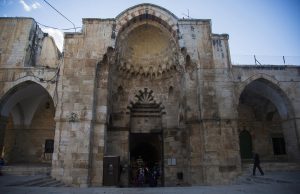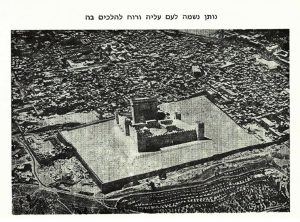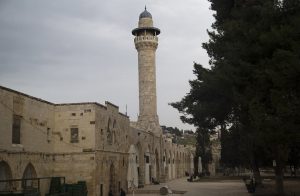Dr. Sharif Abu Shammalah
The term “Judaization” refers to the set of measures and policies that the Zionist occupation and the ‘Temple’ movements have adopted towards the city of Jerusalem in general, to change the religious, cultural, Islamic, and Arab character of the city – and at its heart, Masjid al-Aqsa – so that it can transform the identity of the city into a completely Jewish one.
The Judaization endeavour of the Occupation is primarily directed towards three spheres:
- The human being: By distancing the people of al-Quds from the area and public life at Masjid al-Aqsa, both physically and morally.
- The land: What is upon, and beneath it, encompassing the ongoing phenomena of demolishing homes, or exercising control over them and preventing their restoration; the confiscation of lands and cemeteries; the changing of names of streets and landmarks; and the excavations and tunnelling at Al-Aqsa and its surroundings.
- The holy places: At the heart of this lies Masjid al-Aqsa, which is the locus of the storm of Judaization.
Judaization of Jerusalem and Masjid al-Aqsa is a long-standing feature of the literature of the modern Zionist movement, as can be evidenced by this saying of its founder, Theodor Herzl: “If one day we get Jerusalem, and I am still alive and able to do anything, I will remove everything that is not sacred to the Jews, and I will burn relics of centuries gone by.”
In shedding light on the Judaization of Masjid al-Aqsa, a wide range of measures and policies of Judaization practiced by the occupation are observed. It, however, should always be remembered that the ultimate goal of the occupation is to destroy Masjid al-Aqsa in order to build a Temple in its place, and that even though the measures of Judaization became much more apparent after the occupation of Jerusalem in 1967, several attempts had long preceded it, especially during the British ‘Mandate’, which was a period for the empowering of the Zionist project on the land of Palestine.
Examples of Judaization include:
- Control of part of Masjid al-Aqsa
The Zionists tried to take control of the Al-Buraq Wall (the Western Wall of Masjid al-Aqsa) in 1929. This sparked the Palestinian Al-Buraq Revolution which thwarted that attempt. The Zionists nonetheless attained control of the Wall in 1967, and demolished the Al-Maghribi Quarter adjacent to it, and have held on to it ever since. (Read more about Al-Buraq Wall and its Judaization).
Since the occupation of the city of Jerusalem, the Israeli Occupation has imposed full control over parts of the mosque. They have confiscated the keys to the Mughrabi Gate (located in the Western Wall of the Al-Aqsa Mosque), and have used it ever since to facilitate extremist break-ins and Israeli police raids of the mosque.
Another site that the occupation took full control of, was the Jumblatt retreat situated at the Dome of the Rock courtyard, which was converted into a police station for the Occupation inside Al-Aqsa, and which has been used to launch many hostilities against the Murabiteen at the mosque.
The Occupation is also in full control of the gates of Masjid al-Aqsa, and bars entrance to young men and women, and murabiteen as it feels fit. In 2017, the Occupation tried to impose electronic gates at the entrances to Al-Aqsa. Palestinians confronted the attempt decisively until they were removed after two weeks of sit-in and protest, which came to be known as the Bab al-Asbat uprising.
The Occupation at present seeks to confiscate Bab ar-Rahmah and the entire eastern region of Al-Aqsa, which constitutes a fifth of the area of the mosque, in order to establish a synagogue.
For details, see topics:
- The Temporal and spatial division plan (2013).
- The battle to protect Al-Aqsa from temporal and spatial division.
- Tunnels and excavations
Since 1967, the Occupation has initiated a steadily increasing number of excavations and tunnels at, and in the vicinity of, Masjid al-Aqsa, which according to the latest statistics have reached more than 64 active excavations.
The Zionists claim that these excavations are for the sake of finding traces of the alleged temple. These excavations affect the foundations of Masjid al-Aqsa, and have caused cracks in its walls and foundations, and collapses in the neighbouring homes and structures. They have also resulted in the removal of Islamic archaeological layers that bear witness to the history of Masjid al-Aqsa in the Islamic era.
The dangers of these excavations is amplified by the fact that they are undertaken through a biblical, rather than scientific paradigm, with its proponents seeking to confirm preconceived notions of the existence of a Jewish temple at the site of Masjid al-Aqsa. This approach has prompted some Jewish archaeologists who respect the scientific method to assert that – despite their long involvement with the excavations – they did not find evidence of the existence of Jewish traces in, or below Masjid al-Aqsa. Rather, what they have discovered have only been monuments dating back to the early Islamic or Byzantine eras bearing no connection with the Jews.
- Break-ins
These are ongoing incursions by groups of settlers, Jewish extremists, and foreign tourists into Masjid al-Aqsa under the protection of the occupation army, during which Jewish extremists perform Talmudic rituals. In recent years, these incursions have increased in quantity and have taken on new dimensions, with the active participation of Zionist government and parliamentary figures. These break-ins aim to entrench a Jewish presence at al-Aqsa as to affirm it as the ‘Temple’.
- Impeding a Muslim physical presence at al-Aqsa
In its attempt to thwart an Islamic presence at Masjid al-Aqsa, the Occupation continues to impose age restrictions on the groups of Muslim worshippers permitted to access and pray in the mosque, such that in most cases those under 50 years of age are denied entry. This denial of entry is directed at men especially, forcing thousands of them to pray in the streets outside the mosque, where Israeli occupation checkpoints are erected to prevent them from reaching the site.
This anguish of being denied access to Masjid al-Aqsa extends to all Palestinians, whether they live in the Gaza Strip or the West Bank, or are in the diaspora, with minor and rare exceptions for the elderly.
Circles of learning, performing ribaat at Masjid al-Aqsa, and organised road trips to visit it have also been criminalised. The Israeli Minister of Defense had pronounced the Murabiteen and Murabitaat defenders of Masjid al-Aqsa as terrorists. The Israeli state also wages an organized campaign on shaddul rihaal activities (these are bus trips that transport worshipers from the Palestinian interior to Masjid al-Aqsa). Buses are often stopped and prevented from reaching Masjid al-Aqsa.
Also among the dangerous schemes implemented by the Occupation is the imposition of temporal and spatial division, to facilitate times and spaces wherein Masjid al-Aqsa would be vacant of Muslims, so that settlers could conduct Talmudic Judaic rituals therein, as previously mentioned.
- Altering the names and features of Al-Aqsa
Almost 7000 names of locations in the city of Jerusalem have been changed by the Occuaption. Masjid al-Aqsa too has not been exempt, as the Occupation has always insisted on imposing biblical names on the mosque and its landmarks, with the aim of creating misplaced connections between them al-Aqsa. The most prominent of these is referring to Masjid al-Aqsa as the “Temple Mount”. Doors of the mosque have been slapped with biblical names, an example of which is the Triple Gate being called Huldah. These designations have been affirmed by tourist guides, official proclamations and maps, and placing of signs bearing such nomenclature at the entrances to Masjid al-Aqsa.
- Attempts to burn and bomb Masjid al-Aqsa
The like of what occurred in 1969, when an arson attack destroyed the minbar of Salah al-Din and the walls and furniture of the mosque. The Israeli authorities hindered the firefighting process, and later released the suspect under the pretext of being “mentally unstable” and being incapable of bearing responsibility for his actions. Since then, there have been many other attempts to bomb al-Aqsa, including one in 2015 by an American Jew directed by extremist Zionist organizations. The plot was discovered hours before operation was due to be executed. (For more details click here)
- Preventing maintenance and restoration work inside Masjid al-Aqsa
This policy hinders the essential efforts to preserve, maintain and utilise facilities and spaces at Masjid al-Aqsa. When the mosque’s administrators attempt to carry out even some minor maintenance work, they remain vulnerable to arrest and criminalization. The administration also reports that there are 42 restoration projects at al-Aqsa that are stalled due to the prevention and restrictions of the Occupation.
- Encircling Masjid al-Aqsa
This is achieved by building synagogues at its walls, such as the synagogue in the Madrasa al-Tankaziyya adjacent to al-Aqsa, or below it, such as the Wilson’s Arch synagogue. Jewish associations are active in bringing Jews from all parts of the world to visit these synagogues and to link them to the Holy City. In addition, the Israeli government is building what it calls “biblical gardens” at Islamic monuments surrounding al-Aqsa.
The number of synagogues inside the Old City and Masjid al-Aqsa (an area of less than one square kilometre) has reached 102.
Jewish societies and the Zionist government are competing in planning to demolish Masjid al-Aqsa in preparation for establishing a synagogue in its place, and many models have been built for the temple which they intend to take the place of the mosque.
The aforementioned means of Judaizing Masjid al-Aqsa and its landmarks are brief but prominent examples of some of the challenges that the mosque faces. However, the harsh reality is that the entire Judaization process is yet more ominous and full of painful and disturbing details.


